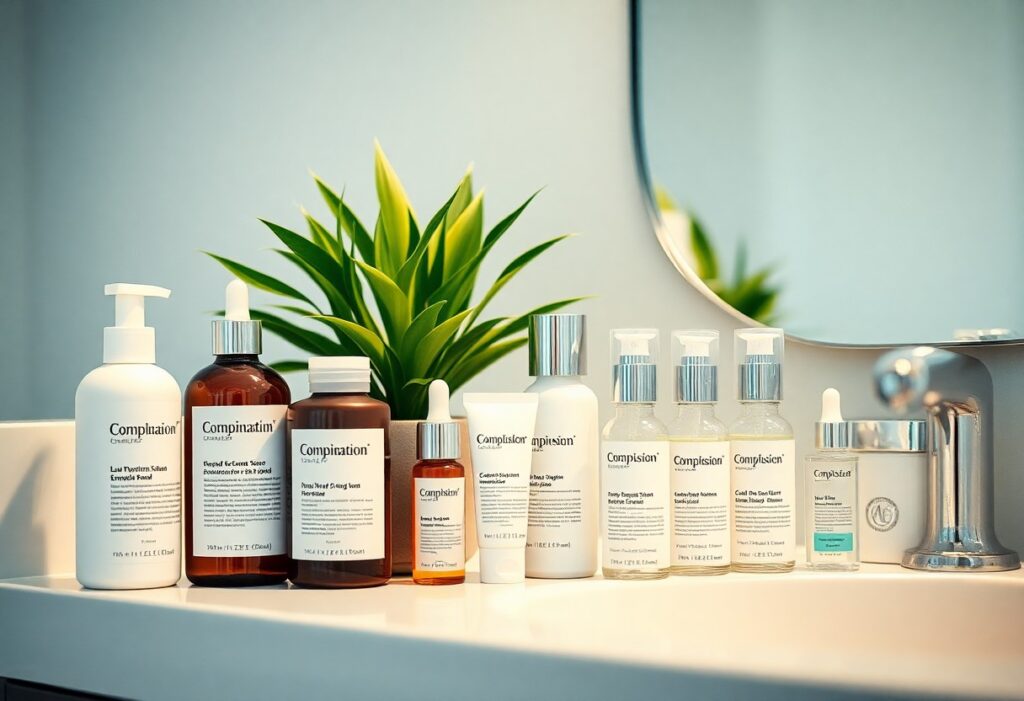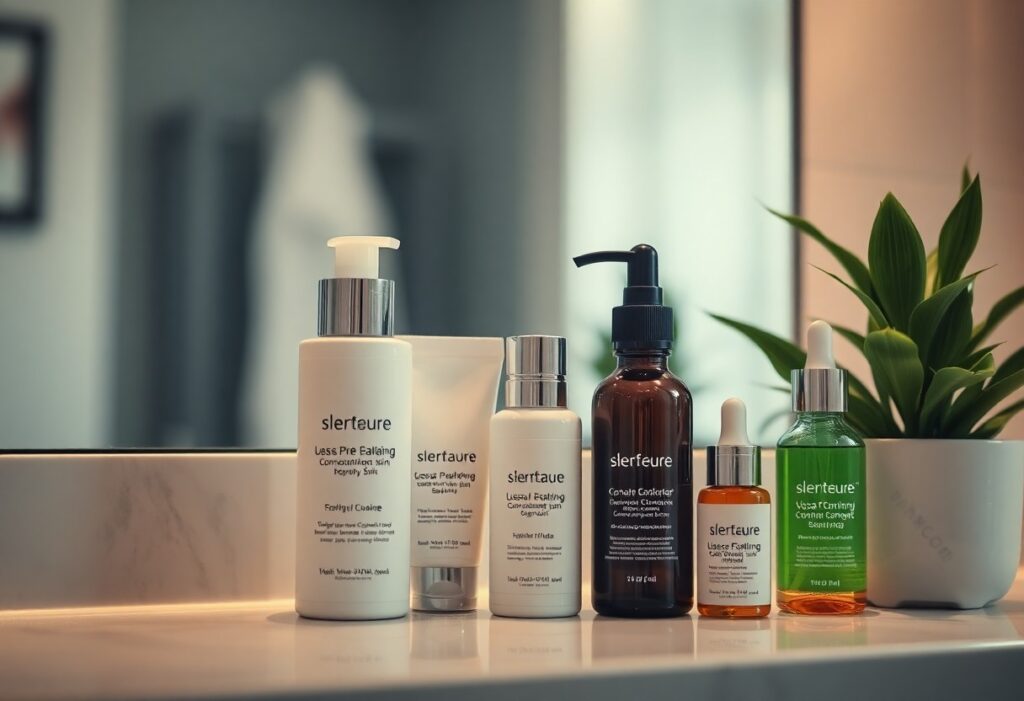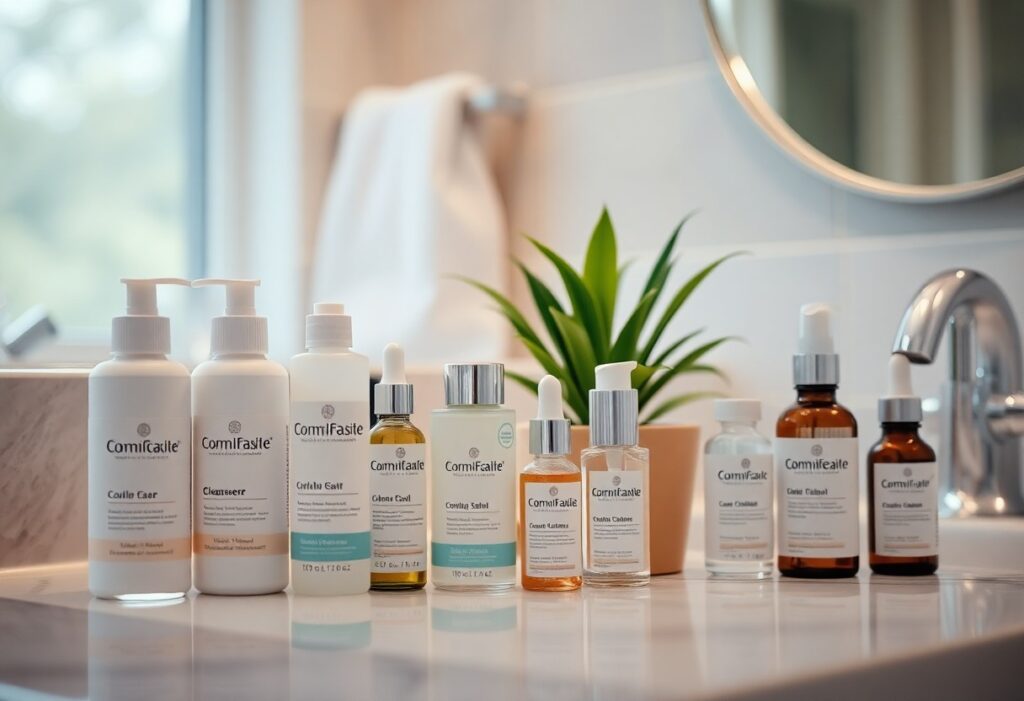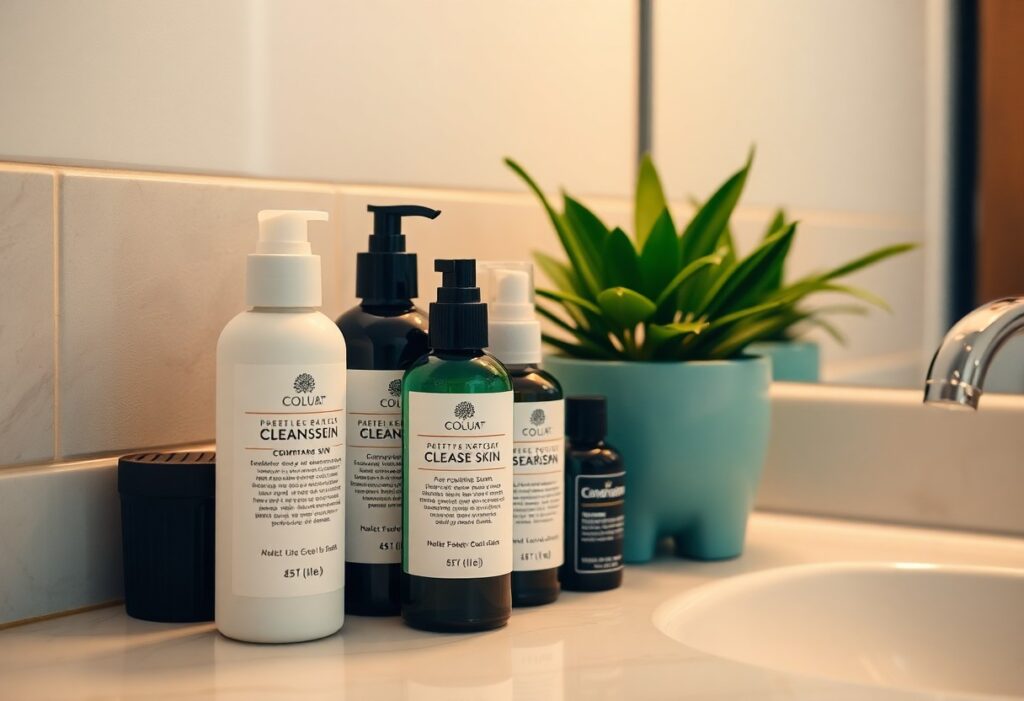Introduction
Your skincare routine for combination skin should address both oily and dry areas while maintaining overall balance. To achieve this, you must select products that hydrate dry patches without exacerbating oiliness in your T-zone. Incorporating gentle cleansers, lightweight moisturizers, and targeted treatments is important for a healthy complexion. By understanding your skin’s needs, you can effectively nurture it and avoid common pitfalls that lead to breakouts or dryness. This guide will walk you through the best practices tailored specifically for your unique skin type.
Understanding Combination Skin

The first step in establishing an effective skincare routine is understanding your skin type, and if you have combination skin, you are not alone. This skin type is a blend of two or more skin types, typically oily in the T-zone (forehead, nose, and chin) while remaining dry or normal on the cheeks and other areas.
Defining Combination Skin
Below, you will find that combination skin requires thoughtful attention as it involves managing varying skin needs in different areas. This uniqueness can make your skincare routine both exciting and challenging.
Common Characteristics
Characteristics of combination skin include varying oil levels and hydration across your face. You might notice your T-zone tends to be shiny and may experience clogged pores, while your cheeks can feel dry and tight, leading to differing moisture needs.
Skin with this type often displays visible pores concentrated in the oily areas, yet you could also experience flakiness or sensitivity on the drier parts. Understanding these differences will help you select appropriate products that address both dry and oily regions simultaneously, allowing for a more balanced complexion.
Factors Contributing to Combination Skin
Skin that is classified as combination can be influenced by several factors, including:
- Genetics: Your inherited traits can predispose you to this skin type.
- Hormonal changes: Fluctuations can affect oil production, particularly around menstruation or pregnancy.
- Environmental factors: Weather changes can alter your skin’s oiliness and dryness.
- Product use: Some treatments can exacerbate dryness or oiliness depending on their formulation.
Any of these factors can lead to the development of combination skin and should be taken into account when selecting your skincare products.
Contributing factors include your lifestyle, such as diet and stress, which can significantly impact your skin’s appearance. Additionally, seasonal changes can alter your skin’s moisture levels and oil production, leading to shifts in how your complexion behaves. Regular assessment of your skincare routine is recommended to adapt to these changes:
- Diet: A balanced diet rich in antioxidants can improve your skin’s resilience.
- Hydration: Drinking plenty of water helps maintain skin moisture balance.
- Stress management: Lowering stress can positively influence your skin health.
Any awareness and proactive measures taken will assist in managing combination skin effectively, leading to a healthier complexion overall.
Importance of a Tailored Skincare Routine

You may not realize it, but having a skincare routine that is specifically designed for your combination skin can make a remarkable difference in how your skin looks and feels. This tailored approach targets the unique needs of both the oily and dry areas of your face, ensuring your skin stays balanced, healthy, and radiant.
Balancing Oily and Dry Areas
Balancing your skin involves finding the right products that can effectively address the diverse requirements of your face. Using gentle cleansers, lightweight moisturizers, and targeted treatments can help you harmonize the oily T-zone with the dry patches, resulting in a more even complexion.
Preventing Breakouts and Irritation
After identifying the right balance, it is important to prevent breakouts and irritation that so often plague combination skin. Choosing non-comedogenic products and avoiding harsh ingredients minimizes the risk of clogging pores and aggravating sensitive areas, providing you with a smoother skin texture.
Considering the intricacies of combination skin, investing in a skincare routine that prioritizes gentleness can significantly reduce the likelihood of irritation and flare-ups. This means selecting soothing ingredients and maintaining a consistent routine that doesn’t overload your complexion but rather enhances its protective barrier.
Enhancing Overall Skin Health
Breakouts can be disheartening, especially when dealing with combination skin. A tailored routine not only focuses on immediate concerns but also fosters long-term skin vitality. By incorporating products rich in antioxidants and vitamins, you can enhance your skin’s natural defenses and promote an overall radiant look.
Even as you address the immediate needs of your skin, an emphasis on nurturing ingredients will contribute to improved texture and hydration, granting you brighter and healthier skin over time. The right products can create a sustainable glow that reflects your effort in maintaining a tailored skincare routine.
Best Practices for Cleansing
Unlike other skin types, combination skin requires a tailored approach to cleansing that addresses both oily and dry areas without over-drying or irritating your skin.
Choosing the Right Cleanser
After determining your skin’s unique needs, select a gentle, pH-balanced cleanser that effectively removes dirt and makeup without stripping away important moisture. Look for formulations that contain hydrating ingredients like glycerin or aloe vera to support the dry zones while still managing oil in the T-zone.
Cleansing Techniques for Combination Skin
Right cleansing techniques can significantly impact your skin’s health. Start by using lukewarm water to rinse your face, which helps to open pores without aggravating sensitive areas.
Due to the contrasting nature of combination skin, use your fingers gently to massage the cleanser into your skin, focusing on the oily T-zone. Use a softer approach on the dryer areas, ensuring you’re not over-scrubbing. Following this method helps maintain the skin’s natural balance while effectively cleansing away impurities.
Frequency of Cleansing
Across most skin types, cleansing twice daily is a common practice. However, with combination skin, it’s important to assess your skin’s response.
Understanding your skin’s signals is vital. You may find that cleansing in the morning and evening works for your skin, but if your skin feels tight or overly stripped, consider reducing it to once a day, especially if your skin becomes irritated. Prioritize adjusting your routine based on how your skin reacts, ensuring you achieve a healthy, balanced complexion.
Exfoliation Strategies
Your skincare routine for combination skin should include effective exfoliation strategies. Exfoliation helps to remove dead skin cells and improve skin texture, but you need to tailor your approach based on your skin’s needs.
Types of Exfoliants: Chemical vs. Physical
Your choice of exfoliant can greatly affect your skin’s health. There are two main types:
| Chemical Exfoliants | Contain acids or enzymes that dissolve dead skin cells without scrubbing. |
| Physical Exfoliants | Involve scrubs or tools that manually buff away dead skin cells. |
| AHA (Alpha Hydroxy Acids) | Water-soluble acids derived from fruits, great for dry areas. |
| BHA (Beta Hydroxy Acids) | Oil-soluble acids perfect for oily zones; they penetrate pores. |
| Exfoliating Scrubs | Granular products that you massage on your skin for immediate results. |
The right choice of exfoliant allows for a balanced and effective skincare regimen.
How Often to Exfoliate
Between your combination skin’s needs and sensitivities, it’s important to find the right balance in how often you exfoliate. Typically, you should aim to exfoliate 1 to 3 times per week, depending on your individual skin’s tolerance.
Often, starting with once a week can help you assess how your skin reacts. If you notice a positive change in texture and luminosity without irritation, gradually increase to twice. However, be cautious of over-exfoliating, which can lead to inflammation and compromise your skin barrier.
Exfoliation for Different Skin Concerns
One of the key aspects of a proper exfoliation strategy involves addressing specific skin concerns. Are you dealing with acne, hyperpigmentation, or dry patches? Tailoring your approach can enhance results.
With targeted exfoliation, you can combine different types of exfoliants as needed. For instance, using a BHA exfoliant for oily areas will help prevent breakouts, while AHA exfoliants can improve dry patches. Always pay attention to your skin’s reaction and adjust accordingly to ensure you’re achieving optimal outcomes.

Hydration and Moisturization
Despite having combination skin, achieving the right balance of hydration and moisturization is vital for maintaining a healthy complexion. Your skin requires both moisture and hydration to thrive, and it’s crucial to choose products that cater to your unique needs.
Selecting Lightweight Moisturizers
Along with selecting a suitable cleanser, you should focus on using lightweight moisturizers that won’t weigh down the oilier areas of your skin. Gel-based formulas or lotions are excellent options as they provide hydration without making your skin feel greasy.
Ingredients to Look For
Against choosing heavy creams, opt for moisturizers that contain beneficial ingredients such as hyaluronic acid, glycerin, and niacinamide. These components hydrate and nourish your skin while preventing excess oil production.
Understanding how these ingredients work can highlight their importance. Hyaluronic acid acts as a moisture magnet, drawing water into your skin and keeping it supple, while glycerin offers hydration without adding oiliness. Niacinamide helps to regulate oil production, making it ideal for combination skin. Incorporating these ingredients will aid in achieving a balanced complexion and maintaining your skin’s health.
The Importance of Hydrating Mists
Mists provide a refreshing burst of hydration that your skin craves throughout the day. They can be applied over makeup or bare skin, enhancing your skin’s moisture levels without disrupting your routine.
Look for hydrating mists that contain ingredients like aloe vera, rose water, or cucumbers, which provide soothing and hydrating benefits. Using a hydrating mist not only refreshes your skin but can also help to set your makeup and provide a dewy finish. Incorporating mists into your routine can significantly improve your skin’s overall hydration, making it feel revitalized and glow.
Sun Protection
Once again, sun protection is a vital step in your skincare routine, especially for combination skin. It helps prevent skin damage, premature aging, and uneven texture. Applying the right sunscreen is crucial to maintain your skin’s balance.
Types of Sunscreens Suitable for Combination Skin
Below is a breakdown of the types of sunscreens that work best for your skin type:
| Type | Description |
| Physical Sunscreens | Contain zinc oxide or titanium dioxide; offers broad-spectrum protection and is less irritating. |
| Cream Formulas | Provide hydration for dry areas while being comfortable on oily areas. |
| Gel-Based Sunscreens | Lightweight and great for oily zones, preventing a greasy finish. |
| Oil-Free Formulations | Prevent clogging pores, making them suitable for combination skin. |
| Non-Comedogenic Products | Specifically designed not to block pores, keeping your skin clear. |
Assume that finding the right sunscreen for combination skin will help maintain a healthy, balanced complexion.
Daily Sun Protection Tips
Skin requires daily care to protect against harmful UV rays. Follow these practical tips to ensure effective sun protection:
- Apply a broad-spectrum sunscreen with at least SPF 30 daily.
- Reapply sunscreen every two hours, especially if you’re sweating or swimming.
- Wear UV-blocking sunglasses to protect the sensitive skin around your eyes.
- Seek shade during peak sun hours (10 AM – 4 PM) whenever possible.
- Consider using a moisturizer with built-in sun protection for added benefits.
After implementing these tips, you can significantly enhance your skin’s health and appearance.
Plus, you can also include other protective measures in your routine. Opt for a wide-brim hat and protective clothing when you spend time outdoors. These additional barriers help shield your skin from UV rays. Here are some helpful suggestions:
- Choose a hat with a minimum of 3 inches for better coverage.
- Wear tightly woven fabrics that reflect UV rays.
- Look for clothing with predefined UV protection.
- Plan outdoor activities for early morning or late afternoon.
- Stay hydrated to maintain skin’s vitality.
After following these suggestions, your skin will appreciate the extra care and protection.
Addressing Sun Damage for Combination Skin
One of the challenges with combination skin is addressing the potential sun damage that can occur over time. Knowing how to treat sun damage effectively will improve your skin’s overall appearance.
Even minor exposure to UV rays can result in hyperpigmentation and premature aging, especially on combination skin. Utilize products with ingredients such as vitamin C, which helps reduce discoloration and promotes a more even skin tone. Incorporating retinoids into your routine can also assist in repairing skin damage and boosting collagen production. Be consistent, as continual care improves your skin’s condition.
Nighttime Skincare Routine
Not only does a nighttime skincare routine help to cleanse and rejuvenate your skin, but it also plays a vital role in repairing damage that occurs throughout the day. During sleep, your skin undergoes a natural renewal process, making it important to provide it with the right products tailored to your combination skin type.
Importance of a Night Routine
On a daily basis, your skin is exposed to pollution, UV rays, and other environmental stressors. When you establish a nighttime regimen, you create an opportunity for your skin to recover and maximize its regenerative abilities while you sleep.
Key Products for Night Care
To ensure your skin gets the nourishment it needs at night, focus on a few key products: a gentle cleanser, a hydrating toner, a targeted serum, and a rich moisturizer. These will help to unclog pores, balance oil production, and keep your skin hydrated.
At the core of your nighttime routine should be a gentle cleanser to remove makeup and impurities. Follow up with a hydrating toner that balances your skin’s pH levels. Next, opt for a targeted serum containing ingredients like hyaluronic acid or niacinamide to address your skin’s specific concerns. Finally, seal in the moisture with a rich moisturizer to prevent dryness.
Adjusting Routine Based on Seasonal Changes
Any good skincare routine should adapt to the changing seasons. As the weather shifts, your skin’s needs may vary. Make sure to evaluate your products regularly to ensure they continue to work effectively for your combination skin.
Seasonal changes can affect your skin’s hydration levels and oil production. You may find that during the colder months, you need an extra layer of moisture to combat dryness. Conversely, in warmer weather, you might want to switch to lighter formulations to avoid feeling greasy. By closely monitoring your skin’s response to seasonal shifts, you can maintain optimal balance and health for your combination skin throughout the year.

Final Words
Summing up, understanding how to care for your combination skin is vital for achieving a balanced complexion. By customizing your skincare routine to address both oily and dry areas, you can optimize your products for maximum effectiveness. Incorporate gentle cleansers, appropriate exfoliators, and targeted moisturizers to maintain hydration without clogging pores. Regularly assess your skin’s needs as the seasons change or your lifestyle shifts, and adjust your routine accordingly to keep your skin healthy and radiant. With the right approach, you can enjoy a beautiful, glowing complexion that meets the unique needs of your skin type.
FAQ
Q: What products are best for cleansing combination skin?
A: For combination skin, a gentle foaming cleanser or a cream-based cleanser works well. Look for products that remove dirt and excess oil without stripping moisture. Ingredients like aloe vera or chamomile can help soothe any dry areas, while salicylic acid can target oilier zones.
Q: How should I moisturize combination skin?
A: When moisturizing combination skin, opt for a lightweight, oil-free moisturizer. Gel-based formulas are ideal as they hydrate without making the skin feel greasy. You may also consider using different products for specific areas, applying a richer cream on dry patches and a lighter lotion on oily zones.
Q: Is it necessary to exfoliate combination skin, and how often should I do it?
A: Yes, exfoliation is beneficial for combination skin as it helps remove dead skin cells and promotes cellular turnover. A gentle exfoliant, such as one with lactic acid or a mild physical scrub, can be used 1-2 times a week. Pay attention to your skin’s response, and adjust frequency if you notice irritation.
Q: What types of serums are suitable for combination skin?
A: Serums that contain hyaluronic acid are excellent for combination skin since they provide moisture without heaviness. Consider serums with niacinamide as well, which can balance oil production and improve overall skin texture. Avoid overly oily or thick formulations, as they could exacerbate issues in the oily areas.
Q: How can I manage breakouts if I have combination skin?
A: To manage breakouts, look for products with salicylic acid or benzoyl peroxide specifically formulated for combination skin. Spot treatments can be effective on problem areas. Additionally, maintain a consistent skincare routine, and avoid using harsh products that can irritate your skin, leading to increased breakouts.


